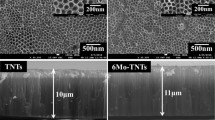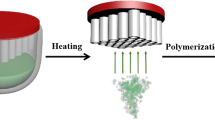Abstract
In this study, we used first principle calculations to investigate the electronic properties of TiO2 modified with eight different elements. Co/Mn co-doped TiO2 nanotube arrays, which had the smallest band gap, were subsequently prepared using electrochemical anodization followed by atomic force microscopy (AFM) and field emission scanning electron microscopy (FE-SEM) measurements. The results showed that the TiO2 nanotube arrays were highly ordered and well aligned. Finally, the photoconversion efficiency was measured using photoelectrochemical experiments and, under the same conditions, the photoconversion efficiency under visible light increased approximately three times from 9.35% for the undoped TiO2 nanotubes to 21.25% for the Co/Mn co-doped TiO2 nanotubes. These results indicate that Co/Mn co-doped TiO2 nanotube arrays can improve the efficiency of visible-light utilization and could be a promising material in such fields as photocatalysis and solar cells.










Similar content being viewed by others
References
Wachs I, Phivilay S, Roberts C (2014) Reporting of reactivity for heterogeneous photocatalysis. Acs Catal 3:2606–2611
Gratzel M (2001) Photoelectrochemical cells. Nature 414:338–344
Youngblood WJ, Lee SA, Kobayashi Y, Emil AH, Paul GH, Thomas AM, Ana LM, Devens G, Thomas E (2009) Photoassisted overall water splitting in a visible light-absorbing dye-sensitized photoelectrochemical cell. J Am Chem Soc 131:926–927
Marszalek MA (2013) Dye-sensitized solar cells. Technol Wind 110:6595–6663
Shen S, Shi J, Guo P, Guo L (2011) Visible-light-driven photocatalytic water splitting on nanostructured semiconducting materials. Int J Nanotechnol 8:523–591
Mills A, Davies RH, Worsley D (1993) Water purification by semiconductor photocatalysis. Chem Soc Rev 22:417–425
Malato S, Fernández-Ibáñez P, Maldonado MI, Blancoa J, Gernjakb WD (2009) Contamination and disinfection of water by solar photocatalysis: recent overview and trends. Catal Today 147:1–59
Yu JC, Ho W, Yu J, Yip H, Wong PK, Zhao J (2005) Efficient visible-light-induced photocatalytic disinfection on sulfur-doped nanocrystalline titania. Environ Sci Technol 39:1175–1179
Hanaor DA, Sorrell CC (2014) Sand supported mixed-phase TiO2 photocatalysts for water decontamination applications. Adv Eng Mater 16:248–254
Fisher MB, Keane DA, Fernández-Ibáñez P, Colreavy J, Hinder S, McGuigan K, Suresh Pillai (2013) Nitrogen and copper doped solar light active TiO2 photocatalysts for water decontamination. Appl Catal B Environ 131:8–13
Williams G, Seger B, Kamat PV (2008) TiO2-graphene nanocomposites UV-assisted photocatalytic reduction of graphene oxide. ACS Nano 2:1487
Mor GK, Varghese OK, Paulose M, Grimes CA (2005) Transparent highly ordered TiO2 nanotube arrays via anodization of titanium thin films. Adv Funct Mater 15:1291–1296
Shankar K, Mor GK, Prakasam HE, Yoriya S, Paulose M, Varghese OK, Grimes CA (2007) Highly-ordered TiO2 nanotube arrays up to 220 µm in length use in water photoelectrolysis and dye-sensitized solar cells. Nanotechnology 18:65707–65718
Shankar K, Mor GK, Adriana FA, Grimes CA (2007) Cation effect on the electrochemical formation of very high aspect ratio TiO2 nanotube arrays in formamide–water mixtures. J Phys Chem C 111:21–26
Hou Y, Li XY, Zhao QD, Quan X, Chen GH (2010) Electrochemical method for synthesis of a ZnFe2O4/TiO2 composite nanotube array modified electrode with enhanced photoelectrochemical activity. Adv Funct Mater 20:2165–2174
Wang J, Qin M, Tao H et al (2015) Performance enhancement of perovskite solar cells with Mg-doped TiO2 compact film as the hole-blocking layer. Appl Phys Lett 106:591
Zhang H, Shi J, Xu X, Zhu L, Luo Y, Li D, Meng Q (2016) Mg-doped TiO2 boosts the efficiency of planar perovskite solar cells to exceed 19%. J Mater Chem A 4:15383
Yu L, Wang Q, Zhi Q et al (2015) Photoelectrochemical properties of alkali metal doped TiO2 nano-honeycomb film. J Energy Environ Focus 4:3
Motlak M, Barakat NA, Akhtar MS, Hamza AM, Taha A, Yang OB, Kim HY (2013) Enhancement the conversion efficiency of the dye-sensitized solar cells using novel Ca-doped TiO2 nanofibers. Energy Environ Focus 2:217–221
Liu Q, Zhou Y, Duan Y, Wang M, Zhao X, Lin Y (2013) Enhanced conversion efficiency of dye-sensitized titanium dioxide solar cells by Ca-doping. J Alloys Compd 548:161–165
Kim SK, Gopi CV, Lee JC et al (2015) Enhanced performance of branched TiO2 nanorod based Mn-doped CdS and Mn-doped CdSe quantum dot-sensitized solar cell. J Appl Phys 117:877–885
Wang J, Li Y, Shen Q et al (2015) Mn doped quantum dot sensitized solar cells with power conversion efficiency exceeding 9%. J Mater Chem A 4:877–886
Tipparach U, Samran B, Kodtharin N (2016) Fabrication and characterization titania nanotubes by anodization for hydrogen generation. J Sci Technol 23:7–43
Wang C, Chen ZJ et al (2014) Enhancing visible-light photoelectrochemical water splitting through transition-metal doped TiO2 nanorod arrays. J Mater Chem A 2:17820–17827
Firoozi N, Dehghani H, Afrooz M (2015) Cobalt-doped cadmium sulfide nanoparticles as efficient strategy to enhance performance of quantum dot sensitized solar cells. J Power Sources 278:98–103
Shi JY, Leng WH, Cheng XF et al (2007) Preparation of cobalt and nitrogen codoped TiO2 thin films and their photoelctrochemical performance. Chin J Nonferrous Metals 17:1536–1542
Archana PS, Naveen KE, Vijila C, Ramakrishna S, Yusoffc MM, Jose R (2013) Random nanowires of nickel doped TiO2 with high surface area and electron mobility for high efficiency dye-sensitized solar cells. Dalton Trans 42:1024–1032
Mohamed NM, Bashiri R, Chong FK, Sufianb S, Kakooei S (2015) Photoelectrochemical behavior of bimetallic Cu–Ni and monometallic Cu Ni doped TiO2 for hydrogen production. Int J Hydrogen Energy 40:14031–14038
Wang Y, Hao Y, Cheng H, Ma J, Xu B, Li W, Cai S (1999) The photoelectrochemistry of transition metal-ion-doped TiO2 nanocrystalline electrodes and higher solar cell conversion efficiency based on Zn2+-doped TiO2 electrode. J Mater Sci 34:2773–2779. https://doi.org/10.1023/A:1004658629133
Liu Q, Yang Z, Duan Y et al (2013) Improved photovoltaic performance of dye-sensitized solar cells (DSSCs) by Zn+ Mg co-doped TiO2 electrode. Electrochim Acta 95:48–53
Wang KP, Teng H (2009) Zinc-doping in TiO2 films to enhance electron transport in dye-sensitized solar cells under low-intensity illumination. Phys Chem Chem Phys 11:9489–9496
Hamedani HA, Allam NK, Garmestani H, Mostafa AE (2011) Electrochemical fabrication of strontium-doped TiO2 nanotube array electrodes and investigation of their photoelectrochemical properties. J Phys Chem C 115:13480–13486
Zhang J, Bang JH, Tang C, Kamat PV (2010) Tailored TiO2–SrTiO3 heterostructure nanotube arrays for improved photoelectrochemical performance. ACS Nano 4:387–395
Zhang J, Tang C, Bang JH (2010) CdS/TiO2–SrTiO3 heterostructure nanotube arrays for improved solar energy conversion efficiency. Electrochem Commun 12:1124–1128
Lee S, Noh JH, Han HS, Yim DK, Kim DH, Lee JK, Kim JY, Jung HS, Hong KS (2009) Nb-doped TiO2: a new compact layer material for TiO2 dye-sensitized solar cells. J Phys Chem C 113:6878–6882
Chandiran AK, Sauvage F, Casascabanas M et al (2010) Doping a TiO2 photoanode with Nb5+ to enhance transparency and charge collection efficiency in dye-sensitized solar cells. J Phys Chem C 114:15849–15856
Noh JH, Han HS, Lee S et al (2010) A newly designed Nb-doped TiO2/Al-doped ZnO transparent conducting oxide multilayer for electrochemical photoenergy conversion devices. Phys Chem C 114:13867–13871
Zhuan ZY, Yun G, Xiao HX, Yu WB, Zhong BH (2016) Study on the effect of metal-doped TiO2 interface layer on the conversion efficiency of amorphous silicon solar cell. Mater Sci 06:142–148
Mei JE, Guan ZX, Young PJ, Gu HB (2012) Enhancement of the photoelectric performance of dye-sensitized solar cells using Ag-doped TiO2 nanofibers in a TiO2 film as electrode. Nanoscale Res Lett 7:97–103
Jeong NC, Prasittichai C, Hupp JT (2011) Photocurrent enhancement by surface plasmon resonance of silver nanoparticles in highly porous dye-sensitized solar cells. Colloids Surf 27:14609–14614
Rahnejat B (2015) Improved efficiency of dye-sensitized solar cells with Ag-doped TiO2 nanostructured films using different TiCl4 solution concentration. Sci Eng 9:12–13
Duan Y, Fu N, Liu Q, Fang Y, Zhou X, Zhang J, Lin Y (2012) Sn-doped TiO2 photoanode for dye-sensitized solar cells. J Phys Chem C 116:8888–8893
Ling Y, Wang G, Wheeler DA, Zhang JZ, Li Y (2011) Sn-doped hematite nanostructures for photoelectrochemical water splitting. Nano Lett 11:2119–2125
Ansari SG, Tuz ZF, Fouad H et al (2015) Effect of flower extracts on the photoconversion efficiency of dye sensitized solar cells fabricated with Sn-doped TiO2. J Mater Sci: Mater Electron 26:5170–5174
Xu M, Da P, Wu H, Zhao D, Zheng G (2012) Controlled Sn-Doping in TiO2 nanowire photoanodes with enhanced photoelectrochemical conversion. Nano Lett 12:1503
Zhang S, Zhao Z, Liu C et al (2004) Study on the optical properties of Mn-doped TiO2 thin films. J Mater Sci 39:2909–2910. https://doi.org/10.1023/B:JMSC.0000021478.22430.5f
Lu L, Xia X, Luo JK et al (2012) Mn-doped TiO2 thin films with significantly improved optical and electrical properties. J Phys D Appl Phys 45:485102–485109
Goswami P, Debnath RK, Ganguli JN (2013) Photophysical and photochemical properties of nanosized cobalt-doped TiO2 photocatalyst. Asian J Chem 25:7118–7124
Shalan AE, Rashad MM (2013) Incorporation of Mn2+ and Co2+ to TiO2 nanoparticles and the performance of dye-sensitized solar cells. Appl Surf Sci 283:975–981
Shao G (2008) Electronic structures of manganese-doped rutile TiO2 from first principles. J Phys Chem C 112:18677–18685
Seki H, Ishisawa N, Mizutani N, Kato M (1984) High temperature structures of the rutile-type oxides TiO2 and SnO2. J Ceram Soc Jpn 1984:219–223
Li DH, Lin SW, Li SP, Huang X, Cao XK, Li JB (2012) Effects of geometric and crystal structures on the photoelectrical properties of highly ordered TiO2 nanotube arrays. J Mater Res 27:1029–1136
Gaft M, Reisfeld R, Panczer G (2005) Modern luminescence spectroscopy of minerals and materials. Springer, Germany
Joung SK, Amemiya T, Murabayashi M, Itoh K (2006) Relation between photocatalytic activity and preparation conditions for nitrogen-doped visible light-driven TiO2 photocatalysts. App Catal A Gen 312:20–26
Brik Y, Kacimi M, Ziyad M, Bozon VF (2001) Titania-supported cobalt and cobalt-phosphorus catalysts: characterization and performances in ethane oxidative dehydrogenation. J Catal 202:118–128
Voß M, Borgmann D, Wedler G (2002) Characterization of alumina silica and titania supported cobalt catalysts. J Catal 212:10–21
Guo S, Liu J, Qiu S, Liu W, Wang Y, Wu N, Guo J, Guo Z (2015) Porous ternary TiO2/MnTiO3 hybrid microspheres as anode materials with enhanced electrochemical performances. J Mater Chem A 3:23895–23904
Xue L, Zhang C, He H, Teraoka Y (2007) Catalytic decomposition of N2O over CeO2 promoted Co3O4 spinel catalyst. Appl Catal B 75:167–174
Allam NK, Grimes CA (2009) Effect of rapid infrared annealing on the photoelectrochemical properties of anodically fabricated TiO2 nanotube arrays. J Phys Chem C 113:7996–7999
Ansari SA, Khan MM, Kalathil S, Nisar A, Lee J, Cho MH (2013) Oxygen vacancy induced band gap narrowing of ZnO nanostructures by an electrochemically active biofilm. Nanoscale 5:9238–9246
Lv Y, Zhu Y, Zhu Y (2013) Enhanced photocatalytic performance for the BiPO4 − x nanorod. J Phys Chem C117:18520–18528
Acknowledgements
This work is supported by the National Key Research and Development Program of China Science (No. 2017YFB0702300) and the National Natural Science Foundation of China (No. 51671029).
Author information
Authors and Affiliations
Corresponding author
Ethics declarations
Conflict of interest
The authors declare that they have no competing interests.
Rights and permissions
About this article
Cite this article
Wan, Y., Xu, A., Dong, C. et al. Co/Mn co-doped TiO2 nanotube arrays for enhanced photoelectrochemical properties: experimental and DFT investigations. J Mater Sci 53, 9988–10000 (2018). https://doi.org/10.1007/s10853-018-2316-2
Received:
Accepted:
Published:
Issue Date:
DOI: https://doi.org/10.1007/s10853-018-2316-2




